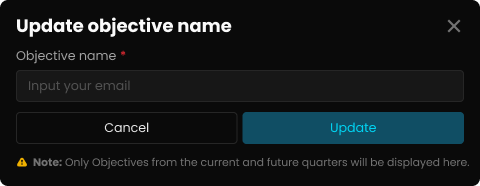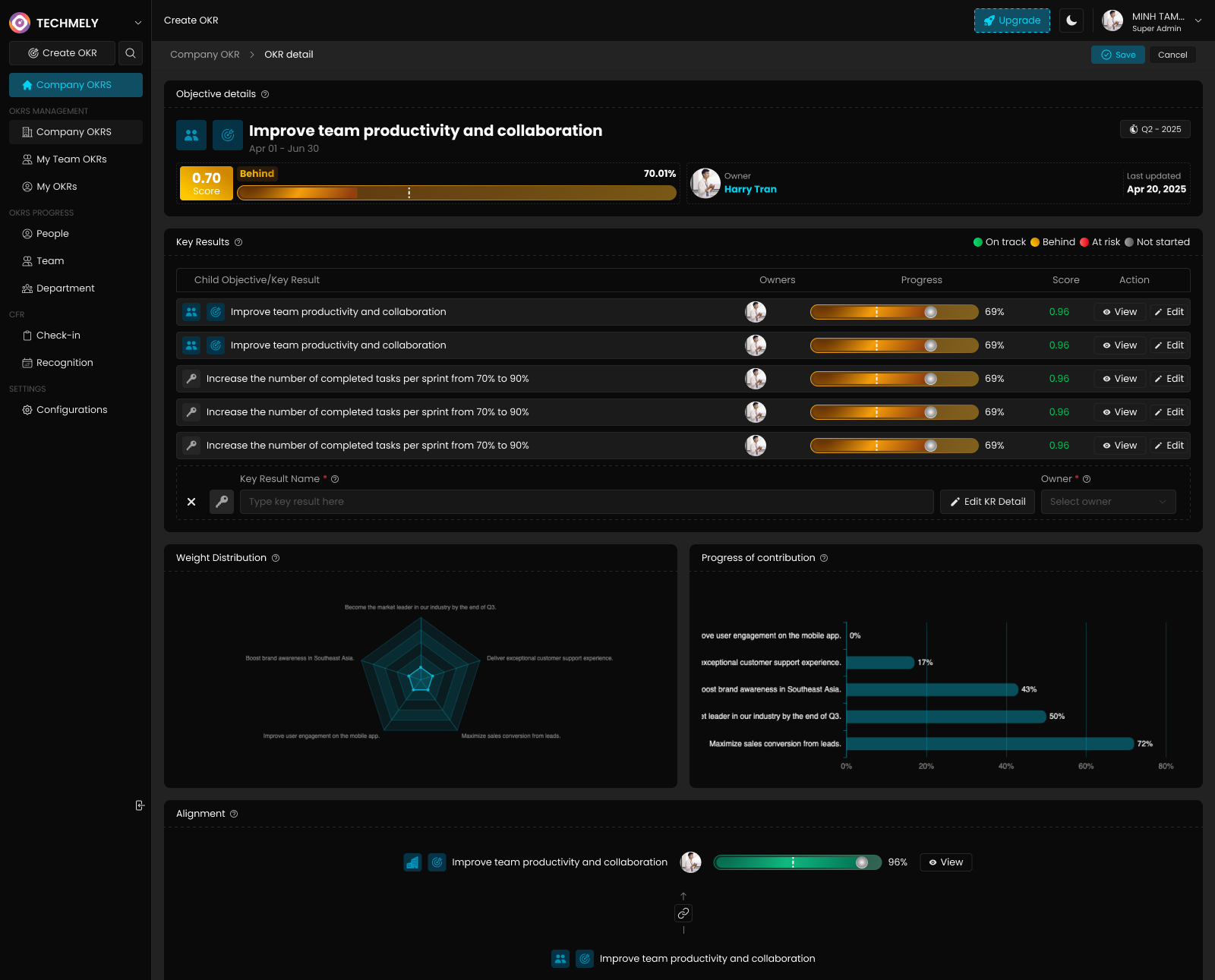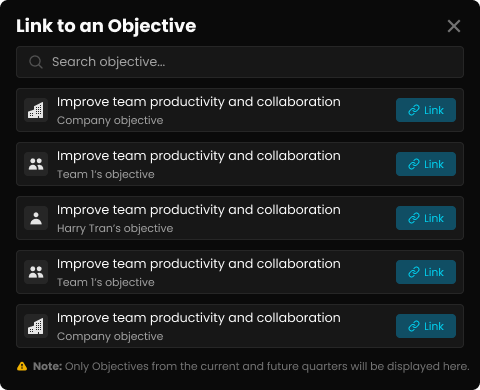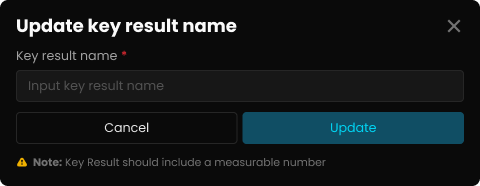Manage OKR Actions
Complete guide to managing OKR actions including editing, updating, linking, and deleting objectives and key results
Manage OKR Actions
Overview
The OKR management interface provides comprehensive tools for editing, updating, and maintaining your objectives and key results. Understanding these actions and when to use them is crucial for effective OKR administration and ensuring your goals remain relevant and achievable.
Available Actions in OKR Detail View
The OKR detail page offers various management actions accessible through buttons and menu options:
Objective-Level Actions
Primary Actions:
- Edit Objective Name: Modify the objective title and description
- Change Owner: Reassign responsibility for the objective
- Link Objective: Connect to parent or related objectives
- Add Key Result: Create new measurable outcomes
- Delete Objective: Remove the objective entirely
Secondary Actions:
- Update Progress: Refresh overall completion status
- Export Data: Download objective information
- Share: Distribute objective details with stakeholders
- Archive: Move completed objectives to archive
Key Result Actions
Individual Key Result Management:
- Edit Details: Modify key result specifications
- Update Progress: Change completion percentage
- View Details: Access detailed key result information
- Delete Key Result: Remove specific key results
- Change Owner: Reassign key result responsibility
Editing Objective Details
Updating Objective Names
When objectives need refinement or clarification, you can modify the title:

Steps to Update Objective Name:
- Click "Edit objective name" in the objective header
- Enter New Title: Type the updated objective name
- Review Changes: Ensure clarity and alignment
- Click "Update": Save the changes
- Verify Update: Confirm the new name appears correctly
Best Practices for Objective Names:
- Keep titles clear and concise
- Use action-oriented language
- Ensure alignment with strategic goals
- Avoid jargon or unclear terminology
- Make them inspiring and motivational
When to Update Objective Names:
- Clarity improvements needed
- Strategic focus shifts
- Stakeholder feedback suggests confusion
- Better alignment opportunities identified
- Language refinement for broader understanding
Adding Key Results
Expanding objectives with additional measurable outcomes strengthens goal achievement:

Process for Adding Key Results:
- Click "Add key result" button
- Define Key Result Details:
- Name and description
- Measurement unit and criteria
- Start and target values
- Weight and importance
- Assign Ownership: Select responsible person
- Set Team Assignment: Choose relevant team
- Configure Progress Tracking: Set up measurement methods
- Save and Activate: Confirm the new key result
Guidelines for New Key Results:
- Ensure measurability and specificity
- Align with objective purpose
- Consider team capacity and resources
- Avoid redundancy with existing key results
- Set challenging but achievable targets
Impact of Adding Key Results:
- Overall objective progress calculation adjusts
- Team workload and responsibilities increase
- Progress tracking requirements expand
- Stakeholder communication updates needed
- Resource allocation may require adjustment
Linking Objectives for Alignment
Creating connections between objectives ensures strategic alignment across organizational levels:

Objective Linking Process:
- Click "Link objective" option
- Search Available Objectives: Browse linkable goals
- Select Parent Objective: Choose appropriate higher-level goal
- Review Connection Logic: Ensure alignment makes sense
- Confirm Link: Establish the relationship
- Verify Alignment: Check connection in alignment view
Benefits of Objective Linking:
- Strategic Alignment: Clear line of sight to company goals
- Progress Cascade: Child progress impacts parent objectives
- Resource Coordination: Better resource allocation decisions
- Communication Clarity: Stakeholders understand connections
- Performance Tracking: Comprehensive progress visibility
Linking Rules and Constraints:
- Cannot link to past or completed periods
- Company objectives cannot be child objectives
- Must maintain logical hierarchical relationships
- Requires appropriate permissions
- Should support strategic coherence
Deleting OKRs and Key Results
Deleting Individual Key Results
When key results become irrelevant or need removal:

Key Result Deletion Process:
- Click Delete Button: Select the key result to remove
- Confirm Deletion: Review the warning message
- Understand Impact: Consider effect on objective progress
- Click "Confirm": Proceed with deletion
- Verify Removal: Ensure key result is no longer listed
Warning Message: "Are you sure you want to delete this key result? This action cannot be undone"
Considerations Before Deleting Key Results:
- Impact on overall objective progress calculation
- Loss of historical progress data
- Effect on team assignments and responsibilities
- Stakeholder communication requirements
- Alternative actions (archiving, modifying instead)
Deleting Entire Objectives
Complete objective removal requires careful consideration:
Objective Deletion Process:
- Access Delete Option: Click the delete button in objective header
- Review Warning: Understand permanent nature of deletion
- Consider Alternatives: Evaluate archiving or modification options
- Confirm Deletion: Proceed only if certain
- Communicate Changes: Inform affected stakeholders
Impact of Objective Deletion:
- Complete loss of progress data
- Removal from alignment structures
- Team assignment changes
- Stakeholder notification requirements
- Resource reallocation needs
Key Result Management Actions
Editing Key Result Details

Key Result Modification Options:
- Name Changes: Update titles and descriptions
- Target Adjustments: Modify goal values
- Progress Updates: Change completion percentages
- Owner Reassignment: Transfer responsibility
- Weight Modifications: Adjust relative importance
- Criteria Changes: Update success measurements
Best Practices for Key Result Updates:
- Document reasons for changes
- Communicate updates to stakeholders
- Maintain historical context
- Consider impact on objective progress
- Ensure continued measurability
Progress Tracking and Updates
Regular Progress Maintenance:
- Weekly Updates: Regular progress percentage adjustments
- Status Changes: Modify risk indicators as needed
- Milestone Tracking: Update based on achievement markers
- Obstacle Documentation: Record challenges and blockers
- Success Celebration: Acknowledge achievement milestones
Progress Update Methods:
- Direct Percentage Entry: Manual progress input
- Slider Adjustment: Visual progress modification
- Milestone Completion: Checkbox or marker-based updates
- Automated Feeds: Integration with external data sources
- Team Collaboration: Shared progress input
Advanced Management Features
Bulk Actions and Mass Updates
Multi-Select Operations:
- Select multiple key results for batch updates
- Apply common changes across multiple elements
- Mass progress updates for related key results
- Bulk owner assignments for team changes
- Simultaneous deletion of multiple items
Efficiency Benefits:
- Reduced administrative time
- Consistent updates across related elements
- Streamlined reorganization processes
- Improved data accuracy
- Enhanced user experience
Import and Export Capabilities
Data Export Options:
- Individual objective details
- Complete OKR hierarchies
- Progress reports and analytics
- Historical data and trends
- Custom format exports
Import Functionality:
- Bulk objective creation
- Key result mass import
- Progress data uploads
- Template application
- Migration support
Workflow Management
Approval Processes
Change Management Workflow:
- Submit Changes: Request modifications
- Review Process: Stakeholder evaluation
- Approval Decisions: Accept or reject changes
- Implementation: Apply approved modifications
- Notification: Inform relevant parties
Approval Requirements:
- Strategic objective modifications
- Resource-intensive changes
- Cross-team impact adjustments
- Timeline extensions
- Budget-related modifications
Version Control and History
Change Tracking:
- Modification History: Complete record of changes
- Version Comparison: Before and after views
- User Attribution: Who made what changes
- Timestamp Documentation: When changes occurred
- Rollback Capability: Ability to revert changes
Historical Analysis:
- Progress trend analysis
- Change impact assessment
- User behavior patterns
- Performance improvement identification
- Learning opportunity recognition
Best Practices for OKR Management
Regular Maintenance Schedule
Weekly Activities:
- Progress updates and status checks
- Blocker identification and resolution
- Team communication and alignment
- Resource requirement assessment
- Quick wins and milestone celebration
Monthly Reviews:
- Comprehensive progress analysis
- Strategic alignment verification
- Resource allocation assessment
- Timeline and target adjustments
- Stakeholder feedback collection
Quarterly Assessments:
- Complete OKR evaluation
- Lessons learned documentation
- Next period planning preparation
- Strategic priority refinement
- Process improvement identification
Change Management Protocol
Before Making Changes:
- Assess impact on related objectives
- Consider stakeholder implications
- Evaluate resource requirements
- Plan communication strategy
- Document rationale and context
During Change Implementation:
- Monitor system functionality
- Track user adoption and feedback
- Address issues promptly
- Maintain communication flow
- Provide necessary support
After Change Completion:
- Verify successful implementation
- Gather feedback and lessons learned
- Update documentation and processes
- Communicate results and outcomes
- Plan for continuous improvement
Troubleshooting Common Issues
Action Failures and Errors
Common Problems:
- Permission denied errors
- Data validation failures
- Network connectivity issues
- System timeout problems
- Concurrent modification conflicts
Solution Approaches:
- Verify user permissions and roles
- Check data format and requirements
- Test network connectivity
- Retry after brief intervals
- Coordinate with other users
Data Consistency Issues
Potential Problems:
- Progress calculation errors
- Alignment relationship breaks
- Owner assignment conflicts
- Timeline inconsistencies
- Reporting discrepancies
Resolution Steps:
- Refresh data and clear cache
- Verify relationship configurations
- Check user and team assignments
- Validate timeline settings
- Contact technical support if needed
Next Steps
After mastering OKR management actions:
- Develop Routine: Establish regular maintenance schedules
- Train Team: Share knowledge with colleagues and team members
- Optimize Workflows: Identify efficiency improvements
- Monitor Impact: Track the effectiveness of management practices
- Continuous Learning: Stay updated with new features and capabilities
Related Topics
- Key Result Management - Detailed key result operations
- OKR Analytics - Understanding progress metrics
- Team Collaboration - Working together on OKRs
- Performance Reviews - Using OKRs in evaluations
Effective OKR management requires understanding all available actions and applying them thoughtfully to maintain goal relevance, team alignment, and organizational success.
Suggested Related Articles
Team Management
Complete guide to creating, managing, and organizing teams within your AntOKR organization for effective collaboration and OKR execution
User Management
Complete guide to managing users, roles, permissions, and team assignments in AntOKR
Key Result Actions
Complete guide to managing key result actions including updating progress, editing details, changing ownership, and deleting key results
Create Team-Level OKR
Step-by-step guide to creating effective team-level Objectives and Key Results in AntOKR
Login
How to access your AntOKR account
Department Management
Complete guide to creating, managing, and organizing departments and teams within your AntOKR organization